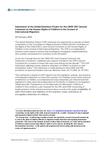Submission of the Global Detention Project for the CMW-CRC General Comment on the Human Rights of Children in the Context of International Migration
29 February 2016
The Global Detention Project (GDP) welcomes the opportunity to provide a written contribution to the Committee on Migrant Workers (CMW) and the Committee on the Rights of the Child (CRC)’s Joint General Comment on the Human Rights of Children in the Context of International Migration. The GDP is an independent research centre based in Geneva that investigates immigration-related detention laws, policies, and practices in countries across the globe.[1]
As per the Concept Note for the CMW-CRC Joint General Comment, this submission is limited to “updating some aspects included in the [CRC] General Comment No. 6, based on issues that have risen during the last decade.”[2] The GDP submission addresses issues related to detention of children in relation to their immigration status.[3] The submission is made bearing in mind CMW and CRC provisions on personal freedom and non-detention (arts. 16, 17 CMW; art. 37 CRC).
This submission is based on GDP research into the legislation, policies, and practices of immigration detention in some 100 countries. Our findings reveal many instances of detention of children, accompanied and unaccompanied, yet relevant domestic legislation is often silent about deprivation of the liberty of children on immigration-related grounds. Transparency on the legal basis for deprivation of liberty of children in this context is a pre-requisite for the CRC and CMW monitoring of implementation of the relevant provisions above as well as the public availability of state information and statistics on the practice, scope, and places of immigration detention of children.
Bearing in mind paragraph 61 of CRC GC No. 6[4], the GDP suggests including the following internationally recognized safeguards to avoid arbitrary detention:
- detention of children on grounds of their, or their parents’ immigration or asylum status as a last resort should by nature not be mandatory;[5]
- detention of children on grounds of their, or their parents’ immigration or asylum status as a last resort should be for the shortest time possible and be clearly time-bound;[6]
- detention of children on grounds of their, or their parents’ immigration or asylum status as a last resort should be reviewed on a regular basis to assess the on-going need for it.
In light of paragraph 63 of CRC GC No. 6 on conditions of detention in the exceptional case of detention, children should be separated from accused or convicted persons, both adults and children.
Finally, in cases where detention of children on grounds of immigration or asylum status is prohibited in law, or when alternatives to children detention are provided, CRC and CMW monitoring should assess that custodial situations for the placement of children do not rise to the level of immigration detention.[7] This issue is particularly important in light of efforts by some governments in recent years to avoid criticism concerning the detention of immigrant and asylum-seeking children by changing the names of detention centres to “child welfare institutions” or other misleading labels.[8]
[1] For more information about the GDP, see: https://www.globaldetentionproject.org/about-the-gdp.
[2] Committee on the Rights of the Child, General Comment No. 6 (2005): Treatment of Unaccompanied and Separated Children Outside Their Country of Origin.
[3] Cf. Concept note “ ii) addressing a number of issues not specifically covered in General Comment No. 6, such as the rights of children affected by migration-related detention and regarding deportation procedures. This is due to the dramatic increase of these kinds of measures, as well as the development of initiatives aimed at protecting children’s rights in such contexts, including the “Best Interest Determination Procedure”, or the policies and programs directed at ending child detention in the context of migration policies.”
[4] In application of article 37 of the Convention and the principle of the best interests of the child, unaccompanied or separated children should not, as a general rule, be detained. Detention cannot be justified solely on the basis of the child being unaccompanied or separated, or on their migratory or residence status, or lack thereof. Where detention is exceptionally justified for other reasons, it shall be conducted in accordance with article 37 (b) of the Convention that requires detention to conform to the law of the relevant country and only to be used as a measure of last resort and for the shortest appropriate period of time. In consequence, all efforts, including acceleration of relevant processes, should be made to allow for the immediate release of unaccompanied or separated children from detention and their placement in other forms of appropriate accommodation.
[5] See CERD/C/AUS/CO/15-17, CAT/C/AUS/CO/4-5, CAT/C/USA/CO/3-5, CAT/C/AUS/CO/3), CCPR/C/79/ADD.122, CCPR/C/AUS/CO/5, CERD/C/CAN/CO/19-20
[6] CRC/C/AUS/CO/4, CRC/C/MLT/CO/2,
[7] See Global Detention Project, “Children in Immigration Detention: Challenges of Measurement and Definition,” June 2015. Available at: https://www.globaldetentionproject.org/publications/children-immigration-detention-challenges-measurement-and-definition
[8] See, for instance, Texas Observer, “Health Agency to Press Forward with Licensing Child Detention Centers,” 12 February 2016, http://www.texasobserver.org/detention-center-child-care-to-hhsc/.



